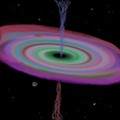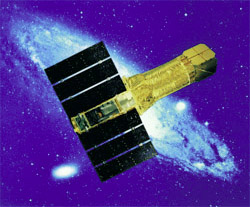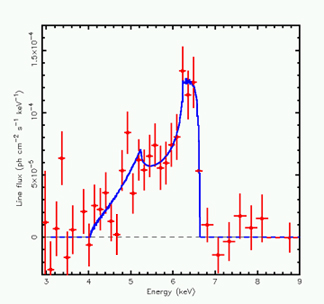Profile: Dr. Kirpal (Paul) Nandra
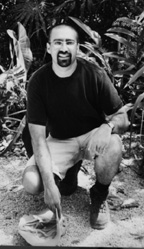
Biography
Dr. Paul Nandra was born and raised in North Shields, England. Now, he works at Goddard Space Flight Center through a contract appointment with Universities Space Research Association. He received a prize in 2000 from the American Astronomical Society for outstanding achievement by a young astronomer.
Paul came from a family of scientists - both his parents are biochemists. How did Paul wind up in astrophysics, then? "My mother claims I was always interested in the stars, but I can't remember that," Paul says. "My dad encouraged me to do science since he thought it would help me get a good job. At about 16 I got excited about the things going on at CERN (a particle physics laboratory in Europe, where scientists smash sub-atomic particles together at near the speed of light), and I decided I wanted to be a particle physicist. When I got to University, though, I realized I wasn't clever enough to do that," Paul quips.
He goes on, "In fact, I was so disillusioned with Physics that I almost changed in my final year of College and became a Computer Scientist. Luckily I didn't, since that year I took two Astronomy courses, which I really liked and even vaguely understood. So of course I decided to do a Ph.D."
Paul attended Churchill College at Cambridge in the UK for his undergraduate work. He then went to Leicester University, also in Great Britain, for his Ph.D.
Paul had the good fortune to be in graduate school when data was pouring down from a new X-ray telescope orbiting the earth. Named Ginga, the satellite was launched by the Japanese in 1987, and allowed astronomers to study the heavens in never-before-seen detail. Ginga means "galaxy" in Japanese, and although the satellite made discoveries about many different kinds of objects, it turned out to be excellent for studying galaxies. And that's just what Paul did: his thesis was on the spectrum of X-rays from "active" galaxies seen by the Ginga satellite.
Research Interests
"My main interest is in the X-ray emission from the nuclei of active galaxies," Paul says. "By looking at the spectrum and variability of the X-rays, we try to work out whether there's a black hole there." Many leading theories hold that supermassive black holes exist at the center of active galaxies, and that matter being sucked into the black holes produces the enormous energy output we see. Paul tries to work out, "what the properties of the black hole are, how much material is being [pulled] onto it," and how it turns that material into energy, particularly X-rays.
» Tell me more about black holes!
Paul was part of an international team of scientists that in 1995 announced evidence for matter swirling around a black hole at the center of a distant galaxy. This time using a new Japanese/US X-ray satellite called ASCA, the team examined an active galaxy known as MCG-6-30-15. ASCA's incredible precision showed something astronomers had predicted but never seen before: the unique X-ray signature of matter orbiting close to a black hole at the center of an active galaxy.
Matter caught by a black hole's gravity forms an accretion disk, spiraling around the black hole before eventually being sucked in. Theories predicted that the extreme gravity of a supermassive black hole in an active galaxy would distort the light we see from the accretion disk. In the same way that a person has to expend energy to climb a hill, light gives up some energy when escaping from close to a black hole. The black hole is at the bottom of a "gravity hill", and the light looses energy "climbing" out.
Paul and the rest of the team used ASCA to isolate X-rays coming from the accretion disk very near the black hole (red crosses in the data plot below). If there was no extreme gravitational field near the inner edge of the disk, the scientists would expect to see two "peaks" in the X-ray spectrum. Instead, the team was delighted to find the lower energy peak was "smeared out," just exactly as the theories for light near a supermassive black hole predicted (blue line in plot).
Paul went on to use ASCA and another US X-ray satellite, the Rossi X-ray Timing Explorer (RXTE) to probe deeper into the nuclei of active galaxies. In 1999, he lead a team of researchers that announced another important breakthrough: they detected X-rays from what looked like matter actually falling into a supermassive black hole at the center of an active galaxy. Before, researchers had detected matter in the accretion disk around a supermassive black hole (like above). Now, however, Paul's team saw the "final cry" of this matter as it actually streamed toward the black hole at more than 6 million miles an hour. ASCA observations had again captured the groundbreaking result, this time in the X-ray spectrum of active galaxy NGC 3516.
» Tell me what Paul is working on now!
Paul's done so much to "illuminate" the inner regions of active galactic nuclei that the American Astronomical Society awarded him the 2000 Newton Lacy Pierce Prize. The Pierce Prize is awarded annually for outstanding achievement in observational astronomical research by a young astronomer. As part of the Prize, Paul will give a lecture to astronomers from around the world at the January 2001 meeting of the American Astronomical Society, to be held in San Diego, California. "I am surprised and delighted to win the award," Paul said. "It feels great to be recognized ... but many others here at NASA and elsewhere deserve a lot of the credit. I'm lucky to have had the opportunity to work with those people and make a contribution to such an exciting subject."
Paul has studied X-ray astronomy and active galaxies for over 10 years now. He's traveled all over the world to do his research, made important discoveries and won awards for his work. Still, he says, the thing he likes most about working in science is, "the opportunity to look at data that nobody else has looked at before. Who knows what might be in there?"
A "Typical" Day at the Office
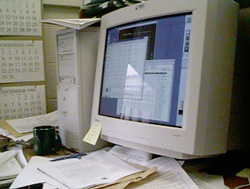
When asked what a "typical" day at the office involves, Paul jokes, "Come in late. Drink coffee. Read my e-mail. Have lunch. Think for a bit. Leave early. Perhaps it would be better if I made something up?"
More seriously, Paul's day involves a number of things. First up is usually reading e-mail: Paul stays in touch with colleagues and collaborators around the world, exchanging science results and coordinating research. Many of Paul's collaborators are in Japan or the UK, and frequently they've sent e-mail during the night describing what they've discovered during their work days.
Next, Paul might check any of several on-line sites where scientific papers are archived and new results are posted. Here, he catches up on the latest discoveries, researches current projects, or seeks inspiration for new ones.
Almost every day involves some work on the computer analyzing data from a satellite telescope of one type or another. Paul uses sophisticated software to model the predicted spectrum of a given astronomical object, and then compares that prediction with actual data taken from space. He might also spend some time writing a proposal to use one or more telescopes to perform new observations. In this way, the discoveries he makes lead to new questions, which in turn suggest new observations and lead to new discoveries.
Other Interests
Paul takes advantage of living in Washington, DC, and on weekends indulges a variety of outside interests. He enjoys music, "especially playing the guitar and bass. I am occasionally seen making an idiot of myself in front of a small audience," he jokes.
Paul also likes playing pool, fishing, cooking, and eating, whether it's a meal he's created or something from one of the many tantalizing restaurants in the Washington area. Having lived in the United States for several years now, Paul's interests also reflect both American and British pastimes: "I like watching baseball and especially cricket, but never get the chance to do the latter in this blighted colony," he laughs.
Questions and Answers
Q: As a scientist, you must be in contact with people from all over the world. What is the most unusual question or comment you have ever gotten?
A: This "fan" e-mail, from one "Mindy B", after my press release on the possible signature of matter falling into the black hole at the center of the galaxy NGC 3516.
Q: If you weren't a scientist, what would you be?
A: I don't know if I would be, but if I weren't a scientist I'd like to have a go at running my own restaurant. I love cooking, especially fancy things, and seeing the reaction of people eating it. Mind you, if they were actually paying for it they might not be quite so polite about what it tastes like ...
Q: Who was your favorite teacher in school? What was this teacher like and how did he/she influence your life?
A: Mr. Gordon the Chemistry Teacher. He ran the Table Tennis club after school and I liked him because he treated us like human beings rather than "schoolkids."
Q: If you could invite three people from throughout history to your house for dinner, who would you invite and why?
A: Motorhead. [Motorhead is a 3-person heavy metal band from Great Britain.]
Q: What one question in science would you like to see answered in your lifetime?
A: The universe is mostly made up of matter that we can't see. It would be nice to know what this matter is and it's one of those things which is currently a real mystery.
Q: Do you have a family? A dog? A fish? A camel?
A: I have a fiancee/co-mortgage-holder, Dinah. We have 9 fish in a pond in the back garden who are occasionally pursued unsuccessfully by our cat, Timmy, who is grey, white and fat.
Q: What is the one big dream you have, or the one thing that you would like to accomplish during your lifetime?
A: To make a century on my Test debut at Lords.
[A "century" is 100 runs at cricket, a British game similar to baseball. A "Test" is a cricket match at the national level, and "Lords" is a famous playing field in Britain where cricket games are held. Paul's comment is the equivalent of an American saying his big dream is, "To hit a grand-slam home run in my first World Series at-bat at Yankee Stadium!"]
Publication Date: September, 2000



